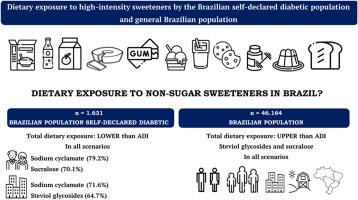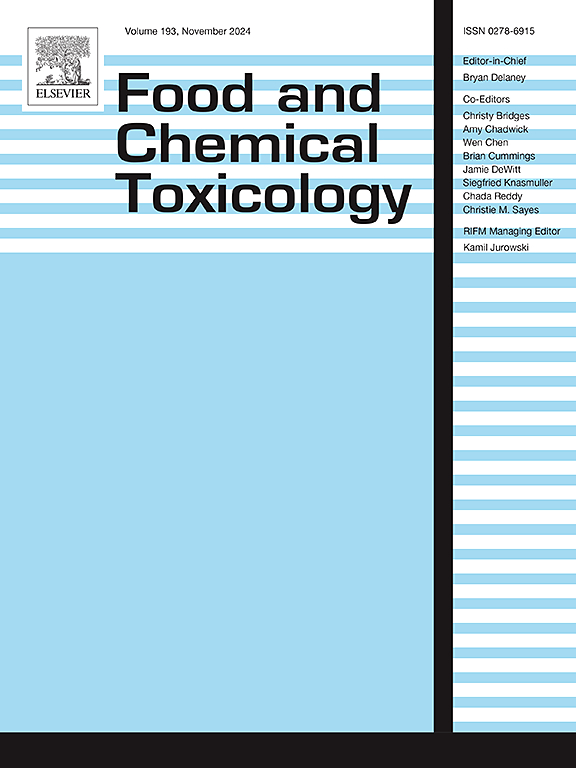巴西自称糖尿病患者和巴西普通人群从膳食中摄入高甜度甜味剂的情况。
IF 3.9
3区 医学
Q2 FOOD SCIENCE & TECHNOLOGY
引用次数: 0
摘要
由于食品中高浓度甜味剂的使用日益增多,以及高浓度摄入对健康的潜在影响,我们根据 2017-2018 年家庭预算调查(POF)中的全国消费数据,估算了巴西人口和自称糖尿病患者人群饮食中高浓度甜味剂的摄入量。通过对在实体店和网上获得的食品进行标注,分两种情况确定了高强度甜味剂的存在情况:平均浓度和最高浓度。根据性别、年龄、居住地和巴西各地区进行分层,得出了自称为糖尿病患者的巴西人口以及普通消费者和仅消费者的巴西人口的食品消费数据。仅就巴西普通消费者而言,甜蜜素、甜菊糖苷和三氯蔗糖的摄入量均超过了每日允许摄入量(ADI),主要是青少年(分别为每日允许摄入量的 131.3%、117.2% 和 123.0%)。在所有计算方案中,糖尿病人群的估计摄入量均低于每日允许摄入量。接触甜蜜素和三氯蔗糖最多的糖尿病人群是女性(分别为每日允许摄入量的 69.6% 和 59.4%)和老年人(分别为每日允许摄入量的 79.2% 和 70.1%)。巴西人口(主要是高消费人群)比自我申报的糖尿病患者更容易接触高强度甜味剂。本文章由计算机程序翻译,如有差异,请以英文原文为准。

Dietary exposure to high-intensity sweeteners by the Brazilian self-declared diabetic population and general Brazilian population
Due to an increasing use of high-intensity sweeteners in foods and potential health implications of high levels exposure, the intake of high-intensity sweeteners present in the diet of the Brazilian population and the self-declared diabetic population, based on national consumption data from the 2017–2018 Family Budget Survey (POF), was estimated. The occurrence of the high-intensity sweeteners was established by labeling foods obtained in physical stores and online, in two scenarios: average and maximum concentration. Food consumption data were derived for the self-declared diabetic Brazilian population and the Brazilian population for average consumers and consumers only, stratified by: sex, age, habitation, and regions from Brazil. For consumers only of the general Brazilian population, the intake of sodium cyclamate, steviol glycosides, and sucralose exceeded the Acceptable Daily Intake (ADI), mainly in adolescents (131.3%, 117.2, 123.0% of respective ADI). The estimated intake for the diabetic population was below ADI in all scenarios calculated. The most exposed diabetic population to sodium cyclamate and sucralose were female (69.6% and 59.4% of respective ADI) and the elderly (79.2% and 70.1% of respective ADI). The Brazilian population, mainly high consumers, was more exposed to high-intensity sweeteners than the self-declared diabetic population.
求助全文
通过发布文献求助,成功后即可免费获取论文全文。
去求助
来源期刊

Food and Chemical Toxicology
工程技术-毒理学
CiteScore
10.90
自引率
4.70%
发文量
651
审稿时长
31 days
期刊介绍:
Food and Chemical Toxicology (FCT), an internationally renowned journal, that publishes original research articles and reviews on toxic effects, in animals and humans, of natural or synthetic chemicals occurring in the human environment with particular emphasis on food, drugs, and chemicals, including agricultural and industrial safety, and consumer product safety. Areas such as safety evaluation of novel foods and ingredients, biotechnologically-derived products, and nanomaterials are included in the scope of the journal. FCT also encourages submission of papers on inter-relationships between nutrition and toxicology and on in vitro techniques, particularly those fostering the 3 Rs.
The principal aim of the journal is to publish high impact, scholarly work and to serve as a multidisciplinary forum for research in toxicology. Papers submitted will be judged on the basis of scientific originality and contribution to the field, quality and subject matter. Studies should address at least one of the following:
-Adverse physiological/biochemical, or pathological changes induced by specific defined substances
-New techniques for assessing potential toxicity, including molecular biology
-Mechanisms underlying toxic phenomena
-Toxicological examinations of specific chemicals or consumer products, both those showing adverse effects and those demonstrating safety, that meet current standards of scientific acceptability.
Authors must clearly and briefly identify what novel toxic effect (s) or toxic mechanism (s) of the chemical are being reported and what their significance is in the abstract. Furthermore, sufficient doses should be included in order to provide information on NOAEL/LOAEL values.
 求助内容:
求助内容: 应助结果提醒方式:
应助结果提醒方式:


